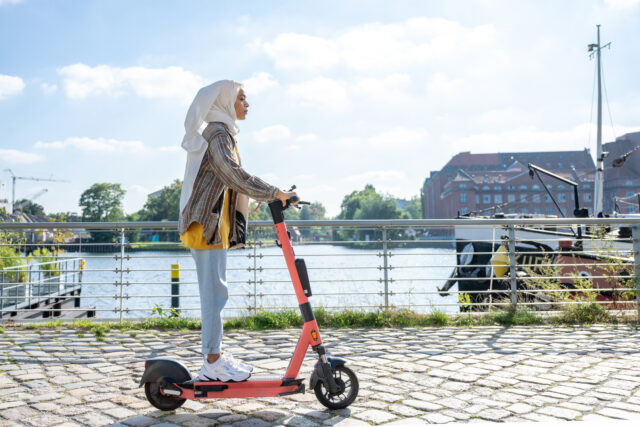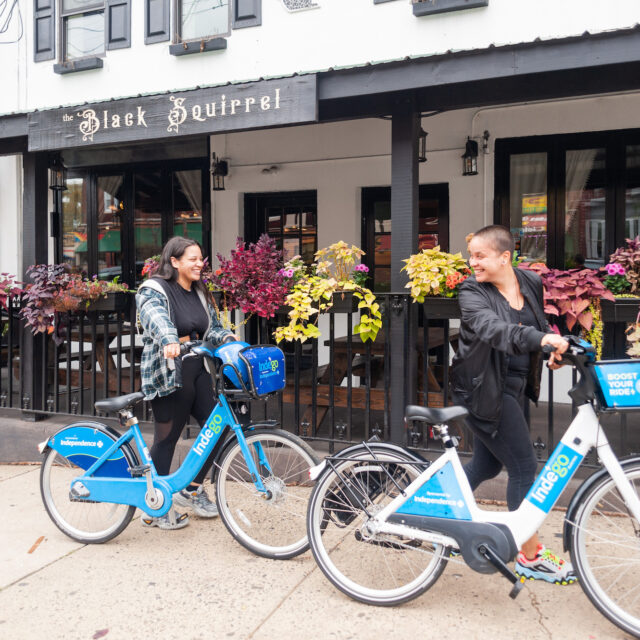Examining the Gender Gap in E-Scooter Share
by Kiran Herbert, Communications Manager
March 15, 2023
A 2022 study speaks to why women are using e-scooter share less and what can be done about it.

The gender gap in shared micromobility is a well-documented phenomenon: when it comes to e-scooter and bike share, women are underrepresented in ridership numbers and underserved by systems around the world. However, it’s one thing to showcase that there are fewer women using shared micromobility (as NABSA’s State of the Industry report does every year) and quite another to study why women are using our systems less, and what can be done to change that.
In 2022, Steer Group, a global consultancy group working across cities, transportation, and infrastructure, partnered with the shared micromobility company Dott on a study to better understand the needs of women using e-scooter share (while funded by Dott, the study was completely independent). Titled “Closing the Gender Gap,” researchers surveyed women in the U.K., Italy, and France who both used Dott’s shared e-scooters, as well as those aged between 18 to 55 who didn’t. Notably, each of the countries had a different level of e-scooter market maturity; while all three countries had a pronounced gender gap in e-scooter use, it was least pronounced in France, the one with the most mature e-scooter market.
“The shared micromobility ecosystem is doing well in terms of ridership and because of that, it’s important to take the gender gap into consideration,” says Alia Verloes, an associate at Steer and one of the study’s leads. “It depends on the country but usually 60 to 70% of users are men versus women, which tells you how deep [the gender gap] is and that it’s a commonality between continents. We wanted to understand the reasons behind this gap and how providers can increase equity.”
As Verloes is quick to point out, the U.S. and Europe have very different definitions of what equity and inclusion mean. Europe tends to talk more about inclusion from an access perspective without the historical background associated with equity and racial inequity that you see in the U.S. Perhaps relatedly, racial data also isn’t collected in Europe like it is in the U.S., meaning the Steer study doesn’t touch on that component in its analysis (although there’s almost always guaranteed to be some component of intersectionality within gender inequality).
In addition to interviews with experts on the gender gap, the study’s literature review offers a comprehensive analysis of the gender gap in bicycling and bike share, highlighting how little research has been done regarding e-scooter share. The bulk of the study, however, focuses on the perceptions of e-scooter share amongst women, as well as the attitudes that push them towards either using shared micromobility or not.
“As a researcher, it’s helpful to have that input on perception, motivations, and barriers because it helps remove the bias that we have when we’re studying something,” says Verloes, emphasizing that studying the gender gap specifically brings up a lot of biases. “The results are really from people just telling us what they think.”
From the survey responses, researchers were able to determine several main factors preventing women in the U.K., Italy, and France from using e-scooter share. Chief amongst them was road safety, followed by women being satisfied with their current transport modes, and the need to travel with bags and luggage. Women also have different travel patterns and needs, and shared micromobility doesn’t often accommodate those that trip chain or have childcare responsibilities. Price, design, and availability all also played a role, as did women’s overall perception of e-scooter share.
Safety: risk perception and lack of cycling infrastructure
- Women tend to prefer to use protected and segregated bicycle lanes and consistently rate road traffic and aggressive driving as significant travel-related concerns.
- The fear factor has more to do with the on-street infrastructure than the devices themselves.
- Road safety was ranked second at 39% by women using Dott’s e-scooters when asked about their top three barriers to use.
- Women tend to be more risk-averse than men.
Design of e-scooters
- The majority of Dott’s female e-scooter users across the UK, Italy, and France stated “women are more likely to be traveling with bags” as one of the top three reasons why fewer women use shared e-scooters compared to men.
- Designs that make vehicles more stable and include baskets or storage space and additional features such as phone holders or even seats would be more appealing to women.
Lack of availability of e-scooters
- A lack of availability of shared e-scooters was ranked third (24%) in the UK, Italy, and France by women using Dott’s e-scooters as a factor discouraging further use. This indicates that the reliability of finding a shared e-scooter is important to women and affects their adoption.
- Many e-scooters don’t service suburban areas, making them harder to use for first/last-mile trips.
Perception of e-scooters by women
- Some women stated that, in their minds, they associate shared e-scooters as being masculine, serving men, and appealing to men’s habits.
- For example, users wrote that they consider e-scooters as “boy toys”, “being something dangerous, and, therefore, more suitable for male users,” “not a sensible mode of transport,” and “men like it because it’s a little bit dangerous and they can show off”.
Price of the service
- As women are more likely than men to have lower incomes, work part-time, and undertake unpaid work at home, expensive transport has a far bigger impact on their lives than it does on the lives of men.
- A high price was ranked fifth by women as a reason for not trying shared e-scooters.
Different travel patterns and needs of women
- The proportionally unequal share of domestic tasks carried out by women and care workers makes shared e-scooters less practical for travel in comparison with a car or public transport due to the need to travel accompanied by others.
- Women are also generally deterred by bad weather more than men. Women can also be more concerned about their appearance, which can discourage travel on shared e-scooters, particularly in poor weather conditions.
Researchers were also able to determine the factors that encouraged the use of shared e-scooters among women. Naturally, infrastructure improvements were at the top of the list. Other research has shown that more protected bike lanes translate to more female cyclists. Not having to maintain a personal vehicle and being able to ride instead of walk were also reasons women noted using e-scooters. Availability was also seen as a motivator — if it’s close and women can access it, they’re more likely to use it.
“Women want to save time,” says Verloes. “They have complicated days, usually taking care of their dependents, so anything that helps them save time is something they might consider versus riding just for fun.”
Many women also pointed out that they use e-scooters at night because it can feel safer than waiting for public transportation. If you live in a place where there aren’t a lot of people around at night — and you don’t have the extra income to take a ride share — e-scooter share can be a great option.
“Among women, there’s a fear related to using transit in the evening after you’ve gone out,” says Verloes. “When you ride an e-scooter it’s safer not being bothered — you have control of your environment.”
Based on the survey responses, Verloes and her team were able to make a series of general recommendations for cities and e-scooter companies everywhere that want to close the gender gap. They include:
- Recognizing there’s a gap. This is important to ensure it’s on the political agenda and that more research gets funded (especially at the local level).
- Investing in safe infrastructure and specifically, connected, protected bike lanes that are well-lit and accessible.
- More training and education, as well as marketing, geared toward women. Offer training designed by and for women. Ensure marketing is designed with the view of changing the representations associated with micromobility.
- Offering subsidies. Offer free rides or discounts to encourage female ridership, and develop pricing schemes that support trip sharing.
- Encouraging women’s involvement in the transportation industry. The transportation sector is male-dominated — equal representation and diversity in decision-making bodies have a positive impact on service design.
As this study shows, the potential to close the gender gap and increase the number of overall shared e-scooters overall is within reach of any interested party. The study also emphasized the untapped pool of women who have expressed interest in trying the service but have not yet done so. Verloes believes additional U.S. research is needed to account for differences in mindset across cultures. She would also like to see the conversation expand beyond just men and women to include the needs and barriers of other marginalized populations, including LGBTQ+ riders. Data, after all, is power.
“We need data so that we can focus on the barriers and perceptions across communities,” says Verloes. “We’ll then do better at finding policy solutions, subsidies, grants, funds, and ideas to redirect the public money and redirect the private effort into the people that really need it.”
The Better Bike Share Partnership is funded by The JPB Foundation as a collaboration between the City of Philadelphia, the National Association of City Transportation Officials (NACTO), and the PeopleForBikes Foundation to build equitable and replicable bike share systems. Follow us on LinkedIn, Facebook, Twitter, and Instagram or sign up for our weekly newsletter. Got a question or a story idea? Email kiran@peopleforbikes.org.



